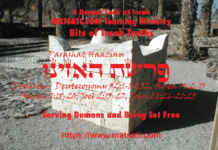This weeks reading is a double portion from Parshiot Vayakhel and Pekudei (Exodus 35:1-40:38). Moshe assembled the entire congregation of Yisrael and said “These are the things that the Lord has commanded you to do.” (NASB) A contribution is to be made to the Lord like it was described in Parashat Terumah (35:5-26). The Scriptures say that 35:21 Everyone whose heart stirred him and everyone whose spirit moved him came and brought the Lord’s contribution for the work of the tent of meeting and for all its service and for the holy garments. (NASB) The scripture details the construction of the curtains (36:9-18) and the construction of the walls of the Tabernacle (36:19-37), construction of the Ark of the Covenant (37:1-15), construction of the utensils used for the daily sacrifice (37:16), construction of the menorah (37:17-22) construction of the altar of incense (37:25-29) and the altar for the burnt offering (38:1-7), and the laver (38:8). The remainder of the reading details the construction of the court of the Tabernacle (38:38:9-20). Moshe gives an accounting of the materials used in the construction of the Tabernacle constructed by Betzalel and Oholiab. Following the construction of the Tabernacle, Moshe assembles everything, anoints them with oil, and commissions Aaron and his sons into the priestly service.
כתבי הקודש / The Holy Scriptures
ספר שמות פרק מ
ח וַיָּקֶם מֹשֶׁה אֶת-הַמִּשְׁכָּן וַיִּתֵּן אֶת-אֲדָנָיו וַיָּשֶֹם אֶת-קְרָשָׁיו וַיִּתֵּן אֶת-בְּרִיחָיו וַיָּקֶם אֶת-עַמּוּדָיו: יט וַיִּפְרֹשֹ אֶת-הָאֹהֶל עַל-הַמִּשְׁכָּן וַיָּשֶֹם אֶת-מִכְסֵה הָאֹהֶל עָלָיו מִלְמָעְלָה כַּאֲשֶׁר צִוָּה יְהוָֹה אֶת-מֹשֶׁה: ס כ וַיִּקַּח וַיִּתֵּן אֶת-הָעֵדֻת אֶל-הָאָרֹן וַיָּשֶֹם אֶת-הַבַּדִּים עַל-הָאָרֹן וַיִּתֵּן אֶת-הַכַּפֹּרֶת עַל-הָאָרֹן מִלְמָעְלָה: כא וַיָּבֵא אֶת-הָאָרֹן אֶל-הַמִּשְׁכָּן וַיָּשֶֹם אֵת פָּרֹכֶת הַמָּסָךְ וַיָּסֶךְ עַל אֲרוֹן הָעֵדוּת כַּאֲשֶׁר צִוָּה יְהוָֹה אֶת-מֹשֶׁה:
Shemot / Exodus 40:18-21
40:18 Moses erected the tabernacle and laid its sockets, and set up its boards, and inserted its bars and erected its pillars. 40:19 He spread the tent over the tabernacle and put the covering of the tent on top of it, just as the Lord had commanded Moses. 40:20 Then he took the testimony and put it into the ark, and attached the poles to the ark, and put the mercy seat on top of the ark. 40:21 He brought the ark into the tabernacle, and set up a veil for the screen, and screened off the ark of the testimony, just as the Lord had commanded Moses. (NASB)
In Parashat Pekudei, we read that Moshe placed the Ten Commandments into the Ark of the Covenant and erected the Tabernacle according to Shemot / Exodus 40:20-21, כ וַיִּקַּח וַיִּתֵּן אֶת-הָעֵדֻת אֶל-הָאָרֹן וַיָּשֶֹם אֶת-הַבַּדִּים עַל-הָאָרֹן וַיִּתֵּן אֶת-הַכַּפֹּרֶת עַל-הָאָרֹן מִלְמָעְלָה: כא וַיָּבֵא אֶת-הָאָרֹן אֶל-הַמִּשְׁכָּן וַיָּשֶֹם אֵת פָּרֹכֶת הַמָּסָךְ וַיָּסֶךְ עַל אֲרוֹן הָעֵדוּת כַּאֲשֶׁר צִוָּה יְהוָֹה אֶת-מֹשֶׁה: 40:20 Then he took the testimony and put it into the ark, and attached the poles to the ark, and put the mercy seat on top of the ark. 40:21 He brought the ark into the tabernacle, and set up a veil for the screen, and screened off the ark of the testimony, just as the Lord had commanded Moses. (NASB) It is interesting to note that the words “Ten Commandments” are never mentioned in the Hebrew Bible. Looking at Shemot / Exodus 40:20 it says הָעֵדֻת meaning “the testimony” and in other places עֲשֶֹרֶת הַדְּבָרִים meaning “the ten words” or “ten utterances” (Shemot / Exodus 34:28, Devarim / Deuteronomy 4:13, 10:4). The “Ten Commandments” are also referred to are as the “Two Stone Tablets” (Shemot / Exodus 34:4), “Tablets of the Torah” (Shemot / Exodus 24:12), “Tablets of Testimony” (Shemot / Exodus 31:18, 32:15, 34:29), or the “Tablets of the Covenant” (Shemot / Exodus 34:28, Devarim / Deuteronomy 4:13, 9:9, 11, 15, 1 Kings 8:9, and 2 Chronicles 5:10). In the rabbinical writings, they are referred to as Aseret ha-dibrot (עשרת הדברות), and in Christian theology they are called the “Decalogue” derived from the Greek words “deca” (ten) and “logoi” (words). The Scriptures suggest that the first tablet contained the first five words that identify our relationship with God and the second tablet contained the last five words which identify our relationship with other people. Rabbinic tradition states that these words comprise a “distilled” subset of the Torah commands that were revealed to Moshe on Sinai, in other words, all of the Torah can be categorized under one of these ten words. Interestingly enough, the Scriptures themselves tend to distill the commandments of the Torah to more general principles that are fewer and fewer in number. David reduced the Torah to eleven (Tehillim / Psalms 15), Isaiah reduced the number to six (Isaiah 33:15-16), Habakkuk reduced it to one saying “But the righteous shall live by his faith” (Habakkuk 2:4). The Apostle Paul used the same technique reducing the commands to the same principle of faith (Romans 1:17, Galatians 3:11, and Hebrews 10:39). This was a common practice in Judaism and Yeshua likewise stated that the requirements of God’s Torah can be summarized in the practice of loving God and loving one another. What can we conclude from all of this? Examining the Hebrew Scriptures in Exodus and Deuteronomy that list the 10 words, both begin with the word “I am” (אנכי) and both end with the word “for your neighbor” (לרעך). The opening and closing words state אנכי לרעך “I am your neighbor” interestingly indicating that what we have done for the least of these (our neighbor), we have done for the Lord Himself. As we love our neighbor and even our enemies as ourselves, we are in effect demonstrating our love for the Lord. This says we are to discard pride and walk humbly before the Lord and each other; only in Christ is this possible! BTT_Parashat Vayakhel-Pekudei-2013








